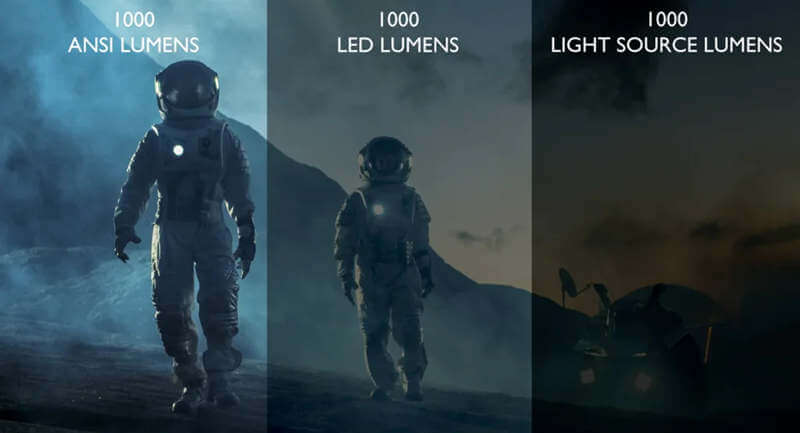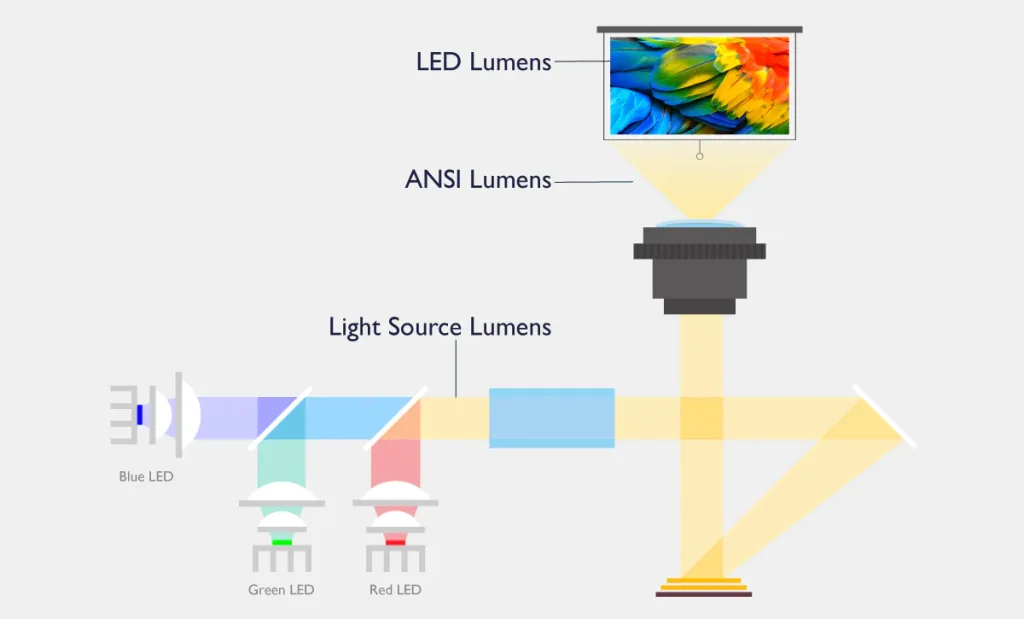Lumens are the common brightness parameter of the projectors. However, different lumen units are adopted by different projector manufacturers in the market, making consumers confused. This article will explain the different brightness units used in the projector area.

Lumens vs ANSI lumens
Lumen is used to describe the luminous flux, which refers to the luminance of the projector. For a projector, it reflects the total quantity of visible light emitted by the projector light source per unit of time. Lumens can be viewed as a general unit of brightness in the projector area.
ANSI lumens reflect the overall amount of light output from a projector and represent the brightness observed on the projection image. It is a formal and widely recognized brightness unit in the projector area. ANSI stands for American National Standards Institute, a non-profit organization founded in 1918.
How to Measure ANSI lumens?
ANSI lumens measure brightness with a 9-point test. Specifically, it measures the brightness of 9 specific points in an entirely white image and calculates the average brightness data.

ANSI lumens= average of the nine Lux readings X image area in square meters
In addition, it has many restrictions on the measurement process. For example, the projector should be the only light source in a room without any reflective surfaces. You can use an illuminance meter to measure the lux of a specific region.
Why Lumens are Important?
Lumens represent the brightness of a projector. For the same lumen unit, the bigger number of lumens, the brighter the projector’s image. If the projector is not bright enough, its image may be blurry and dim during the daytime or under ambient lights. The details of the image can’t be seen clearly.
Different Lumens Units In Projector Market
Though ANSI lumens are widely accepted in the world, there are still many projector manufacturers labeling their products with other units to make their products look more attractive. It is a major pitfall in the projector market, misleading many projector beginners.

For example, the real brightness of a projector is 1000 ANSI lumens, merchant A may label it as 5000 light source lumens; merchant B possibly labels it as 3000 LED lumens; merchant C truthfully labels it as 1000 ANSI lumens. In fact, they have the same brightness.
There are four 4 lumen units in the market, including ANSI lumens, ISO lumens, LED lumens, and light source lumens.
ANSI Lumens vs ISO lumens vs LED Lumens vs Light Source lumens
ANSI Lumens and ISO lumens are internationally recognized units, and both of them have strict measure guidelines. Epson and Philips have announced that they would use the ISO lumen (ISO 21118:2020) to label their projectors.
LED Lumens are only adopted by several projector manufacturers in some regions. LED lumens reflect the brightness sensed by the human eye. It is based on the principle of Helmholtz–Kohlrausch (HK) effect, which regards that the human eye views highly-saturated colors as brighter than they objectively are.

Light source lumens are not international standards for projector brightness either. It indicates the brightness observed directly from the light source of a projector instead of the projection image.
| Lumens Units | ANSI lumens | LED lumens | Light source lumens |
|---|---|---|---|
| Origins | American National Standards Institute (ANSI) | Several LED projector manufacturers | Internationally recognized, but not for measuring a projector’s brightness |
| Purpose | Represent the brightness observed in an image that is projected onto a screen. | Quantify the brightness sensed by the human eye. | Indicate the brightness observed directly from a light source. |
| International Standard | Yes | No | No |
| Calculation Method | Average out the measured brightness of 9 distinct regions of a projection screen | Not totally same among different manufacturers. | Measure a light source’s brightness. |
You can use Projector1’s ANSI lumens to lumens converter to convert different lumen units and keep away from the marketing traps from malicious merchants. You should pay more attention to the lumen units and check the projector parameters table when you choose a projector.
Related posts
Lumen vs Lux: What are the Differences?
LED Lumens VS ANSI Lumens: What Are the Differences?
What are Lumens or ANSI Lumens?
ANSI lumens vs ISO lumens: What Are the Differences?




